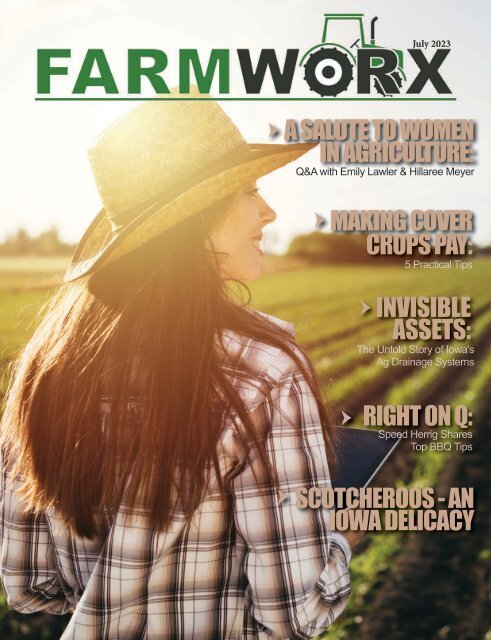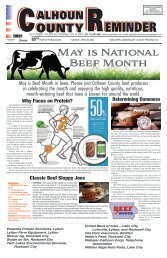July 2023 issue of the Farmworx Magazine
Free agricultural geared magazine published by Dudley Printing, Rockwell City, Iowa
Free agricultural geared magazine published by Dudley Printing, Rockwell City, Iowa
You also want an ePaper? Increase the reach of your titles
YUMPU automatically turns print PDFs into web optimized ePapers that Google loves.
<strong>July</strong> <strong>2023</strong><br />
→<br />
A SALUTE TO WOMEN<br />
IN AGRICULTURE:<br />
Q&A with Emily Lawler & Hillaree Meyer<br />
→<br />
MAKING COVER<br />
CROPS PAY:<br />
5 Practical Tips<br />
→ INVISIBLE<br />
ASSETS:<br />
The Untold Story <strong>of</strong> Iowa's<br />
Ag Drainage Systems<br />
→<br />
RIGHT ON Q:<br />
Speed Herrig Shares<br />
Top BBQ Tips<br />
→<br />
SCOTCHEROOS - AN<br />
IOWA DELICACY
<strong>July</strong> <strong>2023</strong><br />
contents<br />
Free Publication by Dudley Printing. 515 4th St. Rockwell City, IA 50579<br />
If you would like a free copy sent to you, please email us at farmworxmagazine@gmail.com<br />
Publisher - Jason Major<br />
Graphic Designer - Teri Marsh<br />
Advertising Account Executive - Dianne Julian<br />
Editorial Content - Darcy Dougherty Maulsby<br />
→<br />
4<br />
making cover<br />
crops pay:<br />
5 Practical Tips<br />
→<br />
12<br />
Right on q:<br />
Speed Herrig Shares Top BBQ Tips<br />
→ 6<br />
invisible assets:<br />
The Untold Story <strong>of</strong> Iowa's Ag<br />
Drainage Systems<br />
→<br />
15<br />
scotcheroos- an<br />
Iowa Delicacy<br />
→<br />
10<br />
a salute to women<br />
in agriculture:<br />
Special Q&A feature with Hillaree Meyer<br />
→<br />
11<br />
a salute to women<br />
in agriculture:<br />
Special Q&A feature with Emily Lawler<br />
Page 2 <strong>July</strong> <strong>2023</strong>
Gift Certificates<br />
Available<br />
Wilkins Auto Parts<br />
Mark Wilkins<br />
712-464-3163<br />
907 East Main St, Lake City, IA<br />
JASON SHAVER<br />
416 BROWER STREET<br />
ROCKWELL CITY, IA 50579<br />
E-MAIL: shaveragservices@yahoo.com<br />
MORROW’S<br />
SERVICE<br />
TRAILER & EQUIPMENT<br />
RENTALS AVAILABLE!<br />
712-464-3310<br />
223 E. Main St. , Lake City, IA<br />
PUMPS<br />
OPEN 24<br />
HOURS<br />
A DAY!<br />
Contact us for any <strong>of</strong> your drag hose needs.<br />
Eric 712 830-9435 • Zach 712 210-5933<br />
Specializing in<br />
Specializing in<br />
equine and<br />
large<br />
equine<br />
animal<br />
and<br />
large cremation animal<br />
cremation<br />
<strong>July</strong> <strong>2023</strong><br />
• Cremation • Cremation for for pets pets <strong>of</strong> all <strong>of</strong> sizes all sizes<br />
• Urns, • Urns, memorials memorials and and keepsake keepsake items items<br />
• • Pick-up service service available available from from home home or vet or <strong>of</strong>fice vet <strong>of</strong>fice<br />
• • Guaranteed single single pet pet cremation cremation<br />
• • Service area area in Iowa in Iowa and and <strong>the</strong> Midwest <strong>the</strong> Midwest<br />
Scott<br />
Scott<br />
and<br />
and<br />
Aimee<br />
Aimee<br />
Devereaux<br />
Devereaux<br />
22331 590th Street, Pomeroy, Iowa<br />
712-358-2600 • Fax: 712-359-2434<br />
22331 590th Street, Pomeroy, Iowa<br />
712-358-2600 • Fax: 712-359-2434<br />
www.iowapetcremation.com • ashes@ncn.net<br />
www.iowapetcremation.com • ashes@ncn.net<br />
315 1st Street<br />
Templeton, Iowa 51463<br />
712.669.3459<br />
www.nexgenagsupply.com<br />
Page 3
e<br />
m<br />
H<br />
s<br />
James Hepp hosted a “Pr<strong>of</strong>itability with Cover Crops” program in June near Rockwell City.<br />
Making Cover crops pay:<br />
5practical tips<br />
By Darcy Dougherty Maulsby<br />
There’s a lot <strong>of</strong> “feel good” talk today<br />
about <strong>the</strong> role <strong>of</strong> cover crops in<br />
row-crop agriculture. Science shows<br />
<strong>the</strong>y <strong>of</strong>fer many benefits, from increasing<br />
soil organic matter to reducing<br />
soil compaction, erosion and<br />
nutrient run<strong>of</strong>f.<br />
While cover crops are a long-term<br />
investment in improved soil health,<br />
do <strong>the</strong>y really pay? Approximately<br />
70 people ga<strong>the</strong>red at Hepp Farms<br />
near Rockwell City to find answers<br />
during a “Pr<strong>of</strong>itability with Cover<br />
Crops” pogram on June 9.<br />
“I think <strong>the</strong> focus on return on investment<br />
(ROI) is a big reason why<br />
so many people attended,” said<br />
Hepp, 33, a first-generation farmer<br />
from Rockwell City, who grows<br />
1,400 acres <strong>of</strong> corn, soybeans and<br />
cereal rye with his family. “With cover<br />
crops, I’ve learned <strong>the</strong>re’s no $100<br />
silver bullet for success. It takes ten<br />
$10 solutions to make <strong>the</strong> system<br />
work.”<br />
Cover crops are different from<br />
cash crops like corn and soybeans,<br />
which farmers sell for pr<strong>of</strong>it. Cover<br />
crops’ primary job is to improve <strong>the</strong><br />
soil. They are seeded into fields to<br />
provide a “living mulch” between<br />
growing seasons to protect <strong>the</strong> soil<br />
from erosion and nutrient loss. Cover<br />
crops can also help smo<strong>the</strong>r weeds,<br />
manage pests and diseases, and increase<br />
biodiversity on <strong>the</strong> farm. Depending<br />
on <strong>the</strong> type <strong>of</strong> cover crop<br />
seeded, <strong>the</strong> plants ei<strong>the</strong>r winter kill,<br />
or <strong>the</strong>y are terminated before <strong>the</strong><br />
next cash crop starts growing in <strong>the</strong><br />
spring.<br />
Making cover crops work means<br />
investing extra time and attention to<br />
detail, but it’s paying <strong>of</strong>f for Hepp,<br />
who <strong>of</strong>fers his top 5 tips for success:<br />
1. Start small. Hepp began with<br />
80 acres <strong>of</strong> rye cover crop in 2020.<br />
He was inspired by Keith Sexton,<br />
who has a crop-share arrangement<br />
with Hepp and had dabbled in cover<br />
crops. “Planting into rye is scary, and<br />
you’ve got to go on faith,” said Hepp,<br />
whose rye was hip-high when he<br />
planted non-GMO soybeans into his<br />
first cover crop. “I couldn’t see anything<br />
behind <strong>the</strong> planter, but everything<br />
worked fine.” There was also<br />
no yield drag at harvest. This encouraged<br />
Hepp to expand his cover crop<br />
acres to 120 acres in 2021. He now<br />
manages 460 acres <strong>of</strong> cover crops.<br />
“If you’re new to cover crops, start<br />
with some acres that will be plant-<br />
L<br />
S<br />
c<br />
c<br />
t<br />
i<br />
n<br />
b<br />
s<br />
a<br />
h<br />
a<br />
d<br />
a<br />
a<br />
g<br />
s<br />
w<br />
2<br />
3<br />
a<br />
L<br />
g<br />
a<br />
t<br />
g<br />
s<br />
o<br />
1<br />
p<br />
w<br />
t<br />
Page 4 <strong>July</strong> <strong>2023</strong>
<strong>July</strong> <strong>2023</strong><br />
First-generation farmer James Hepp<br />
ed to soybeans <strong>the</strong> next spring. It’s<br />
more difficult to screw that up,” said<br />
Hepp, whose goal is to have all <strong>of</strong> his<br />
soybean acres in cover crops.<br />
2. Try different seeding options.<br />
Late summer (mid-August to early<br />
September) is an ideal time to seed<br />
cover crops. “When we’ve seeded<br />
cover crops into standing corn at<br />
that time, I’ve had 3-inch-tall rye going<br />
into harvest,” Hepp said. “Running<br />
<strong>the</strong> combine over that is nice,<br />
because it’s like driving on turf.” To<br />
seed his cover crops, Hepp has used<br />
aerial seeding from an airplane to<br />
hiring a local farmer with vertical tillage<br />
equipment. Hepp is looking into<br />
drone technology for seeding clover<br />
and o<strong>the</strong>r cover crops. He also has<br />
an air seeder he can put on his Hagie<br />
high-clearance applicator and is<br />
studying <strong>the</strong> best way to make this<br />
work.<br />
3. Test your results. In late May<br />
<strong>2023</strong>, Hepp clipped a 3-foot by<br />
3-foot sample <strong>of</strong> his rye cover crop<br />
and sent <strong>the</strong> sample to Regen Ag<br />
Lab in Pleasanton, Nebraska. (Regen<br />
Ag Lab provides accurate, reliable<br />
testing services surrounding<br />
<strong>the</strong> principles <strong>of</strong> soil health and regenerative<br />
agriculture.) The results<br />
shocked Hepp. “Along with 2.2 tons<br />
<strong>of</strong> dry matter, <strong>the</strong> sample showed<br />
110 pounds <strong>of</strong> potassium and 22<br />
pounds <strong>of</strong> phosphorus,” said Hepp,<br />
who noted that’s enough potassium<br />
to produce 85-bushel-per-acre soybeans.<br />
“This wasn’t even my best rye<br />
cover crop, but <strong>the</strong> tests showed <strong>the</strong><br />
rye has scavenged a lot <strong>of</strong> nutrients.”<br />
While many <strong>of</strong> Iowa’s rich soils<br />
contain abundant nutrients, <strong>the</strong><br />
chemistry and composition <strong>of</strong> certain<br />
soils can make it tough for plants to<br />
absorb <strong>the</strong>se nutrients. Beneficial<br />
soil microbes linked with cover crops<br />
can help “unlock” this natural fertilizer.<br />
“These nutrients are in an organic<br />
form that’s like a slow-release fertilizer<br />
that feeds <strong>the</strong> crops,” Hepp said.<br />
In some cases, this can help lower<br />
<strong>the</strong> fertilizer bill, or it allows farmers<br />
to reallocate fertilizer resources for<br />
more timely, strategic applications.<br />
“I’ve cut back on dry fertilizer applications<br />
and am using more liquid, foliar<br />
feeding during <strong>the</strong> growing season,”<br />
Hepp said. “This allows me to ‘spoon<br />
feed’ my crop <strong>the</strong> nutrients it needs,<br />
when it needs <strong>the</strong>m.”<br />
Cover crops also help suppress<br />
weeds, which can help reduce herbicide<br />
applications. “I try to do only one<br />
post-emerge herbicide pass, if I can,”<br />
Hepp said. “Also, with cover crops in<br />
soybeans, I’m able to skip a residual<br />
herbicide pass and get better weed<br />
suppression, which normally pays for<br />
<strong>the</strong> cost <strong>of</strong> <strong>the</strong> cover crop.”<br />
Roughly 70 people ga<strong>the</strong>red at Hepp Farms near<br />
Rockwell City to learn about making cover crops pay.<br />
4. Set goals. Hepp can’t forget all<br />
<strong>the</strong> “snirt” (dirty snow) that covered<br />
<strong>the</strong> Iowa landscape following a blizzard<br />
right before Christmas 2022.<br />
“Seeing all that black soil in <strong>the</strong> ditches<br />
broke my heart. It also reminded<br />
me why building soil health and holding<br />
that valuable soil in place is my<br />
top goal with cover crops.”<br />
Hepp’s second goal is to increase<br />
efficiency and save time. He has reduced<br />
tillage, thanks to strip tillage<br />
and no-till, and he’s finding ways to<br />
make cover crops work with this system.<br />
Hepp’s third goal for his cover<br />
crops revolves around ROI. He plans<br />
to seed more diverse species <strong>of</strong> cover<br />
crops, since each one supports<br />
certain microbes that provide specific<br />
soil health benefits. “Clovers help <strong>the</strong><br />
microbes that play a role with nitrogen<br />
fixation,” Hepp said. “This potentially<br />
helps you lower your nitrogen<br />
fertilizer bill.” Hepp is also interested<br />
in developing an additional income<br />
stream through custom cover- crop<br />
seeding and raising rye for cover<br />
crop seed.<br />
5. Make cover crops part <strong>of</strong> your<br />
farm management plan. Now that<br />
he has experience seeding cover<br />
crops on corn acres that will be planted<br />
to soybeans, he’s experimenting<br />
with <strong>the</strong> best ways to use cover crops<br />
on soybean acres that will be planted<br />
to corn next spring. “If you’re serious<br />
about cover crops, you need to make<br />
<strong>the</strong>m part <strong>of</strong> your farm management<br />
to-do list,” Hepp said.<br />
Hepp encourages o<strong>the</strong>r farmers<br />
to take advantage <strong>of</strong> cover crop costshare<br />
opportunities through Practical<br />
Farmers <strong>of</strong> Iowa and o<strong>the</strong>r organizations.<br />
Also, seek out o<strong>the</strong>r farmers<br />
with cover-crop experience, and<br />
find online resources like XtremeAg’s<br />
Cutting <strong>the</strong> Curve podcast, he advised.<br />
“I’ve cut my learning curve this<br />
way, and I want to help o<strong>the</strong>rs learn.<br />
If you want cover crops on your acres<br />
and are willing to put some effort into<br />
this, cover crops will work for you.”<br />
Page 5
In <strong>the</strong> late 1800s and early 1900s, crews on dredging machines dug drainage ditches to help tame mosquito-filled sloughs and<br />
transform <strong>the</strong> land into some <strong>of</strong> <strong>the</strong> most fertile ground in <strong>the</strong> nation. (Courtesy <strong>of</strong> Calhoun County Museum)<br />
Invisible Assets:<br />
The Untold Story <strong>of</strong> Iowa's Ag Drainage Systems<br />
By Darcy Dougherty Maulsby<br />
If <strong>the</strong>re were a “Mysteries at <strong>the</strong><br />
Museum” television series geared towards<br />
agriculture, this item would be<br />
ideal to lead in a segment. It’s hollow,<br />
it’s made <strong>of</strong> clay, it contains a message<br />
from <strong>the</strong> past, and it was buried in <strong>the</strong><br />
ground for decades.<br />
It’s a unique clay drainage tile dated<br />
1885, and it’s on display in <strong>the</strong> Greene<br />
County Historical Society’s museum<br />
in Jefferson. The message carved<br />
around <strong>the</strong> exterior <strong>of</strong> <strong>the</strong> tile reads,<br />
“We <strong>the</strong> men who started <strong>the</strong> tile work<br />
did so with a motive to benefit <strong>the</strong> town<br />
and country. Signed T.P. LaRue <strong>of</strong><br />
Scranton, Iowa.”<br />
An interpretive sign by <strong>the</strong> tile<br />
shares a quote from S.J. Melson, a<br />
former Greene County engineer, to<br />
explain <strong>the</strong> curious item’s history. “This<br />
tile was placed into my hands by Carl<br />
Paup on February 1968. Mr. Paup<br />
stated <strong>the</strong> tile was unear<strong>the</strong>d and has<br />
lasted for many years on <strong>the</strong> property<br />
owned and operated by Harrison Paup<br />
<strong>of</strong> Kendrick Township, Greene County,<br />
Iowa."<br />
That tile reflects a major part <strong>of</strong> Iowa’s<br />
agricultural history that has been<br />
buried, literally, for generations, yet this<br />
history continues to influence farming<br />
methods, especially in <strong>the</strong> prairie pothole<br />
regions <strong>of</strong> north-central Iowa and<br />
northwest Iowa.<br />
“In general, ag drainage in Iowa got<br />
its start around 1880, but this varied a<br />
lot, depending on <strong>the</strong> region,” said Joe<br />
Otto, a historian who has worked as<br />
a communications specialist with <strong>the</strong><br />
Iowa Water Center at Iowa State University<br />
and has worked with <strong>the</strong> Soil<br />
and Water Conservation Society.<br />
The first documented case <strong>of</strong> a<br />
drain tile being installed in Iowa occurred<br />
in 1868 on <strong>the</strong> grounds <strong>of</strong> Iowa<br />
State in Ames, Otto added. Before<br />
that, some <strong>of</strong> <strong>the</strong> first drainage ditches<br />
were dug in <strong>the</strong> 1850s along <strong>the</strong> Mississippi<br />
River in Des Moines County,<br />
just upstream from Burlington, so<br />
farmers could help protect <strong>the</strong>mselves<br />
from flooding. One <strong>of</strong> <strong>the</strong>se farmers,<br />
John Williams, was later elected to <strong>the</strong><br />
state legislature and helped get <strong>the</strong><br />
state’s first drainage laws passed in<br />
<strong>the</strong> 1870s, Otto said.<br />
Drainage affected Iowa’s settlement<br />
patterns<br />
Ag drainage was such a major <strong>issue</strong><br />
in <strong>the</strong> 1800s that it impacted Iowa’s<br />
settlement. “Iowa wasn’t settled<br />
east to west, but from <strong>the</strong> bottoms<br />
up to <strong>the</strong> top <strong>of</strong> <strong>the</strong> state's many river<br />
valleys,” Otto said. “Atop <strong>the</strong> river valleys<br />
were <strong>the</strong> flat, glaciated prairies <strong>of</strong><br />
north-central and northwestern Iowa.<br />
These were settled and farmed starting<br />
in <strong>the</strong> 1870s and 1880s - several<br />
decades after farming started along<br />
<strong>the</strong> Mississippi.”<br />
The region’s extensive swamps<br />
and sloughs were remnants <strong>of</strong> <strong>the</strong> last<br />
glacier, which loosened its icy grip on<br />
Iowa approximately 12,000 years ago.<br />
“There was a lot <strong>of</strong> water and nowhere<br />
Page 6 <strong>July</strong> <strong>2023</strong>
for it to go,” Otto said. “Drainage ditches<br />
had to be dug and tile lines had to<br />
be laid before <strong>the</strong> sloughs and swamps<br />
<strong>of</strong> Iowa could be farmed. This started<br />
around 1880 and picked up speed in<br />
<strong>the</strong> early 1900s as drainage technology<br />
became more advanced.”<br />
Ag leaders like Civil War veteran<br />
and pioneer farmer Jesse Allee, who<br />
settled in <strong>the</strong> Newell area in 1871,<br />
knew ag drainage would be essential<br />
to <strong>the</strong> development and prosperity <strong>of</strong><br />
<strong>the</strong> region. “He was far-seeing with<br />
<strong>the</strong> unshakable belief in <strong>the</strong> future <strong>of</strong><br />
<strong>the</strong> community’s farm land,” according<br />
to <strong>the</strong> 1969 Newell centennial history<br />
book at <strong>the</strong> Allee Mansion south <strong>of</strong><br />
Newell. “Jesse worked hard educating<br />
<strong>the</strong> public to <strong>the</strong> necessity <strong>of</strong> proper<br />
drainage if this area was to be a leader<br />
in agriculture.”<br />
Settlers in Greene County faced a<br />
similar situation. “By 1880, many landowners<br />
realized underground drainage<br />
tile was needed to remove <strong>the</strong> excess<br />
water,” wrote James H. Andrew,<br />
a long-time Greene County farmer<br />
who created <strong>the</strong> Farm Drainage Tiling<br />
exhibit at <strong>the</strong> Greene County Historical<br />
Society’s museum in Jefferson before<br />
he passed away in 2014.<br />
As more settlers moved into Iowa<br />
and demand for tile drainage grew, tile<br />
kilns and factories popped up across<br />
<strong>the</strong> state, Otto noted. Greene County,<br />
like many Iowa counties, had multiple<br />
firms manufacturing clay tile. These<br />
businesses used locally-sourced clay.<br />
These companies included Jefferson<br />
Cement Products Co., which was located<br />
just north <strong>of</strong> <strong>the</strong> Greene County<br />
Fairgrounds and operated until about<br />
1930, and Lawton and Mass, which<br />
produced concrete tile at Cooper for a<br />
number <strong>of</strong> years, starting in 1895.<br />
“There were also small machines<br />
made for farmers to mix concrete and<br />
scoop it into a manually-cranked device<br />
that used metal forms to make<br />
various sizes <strong>of</strong> tile,” wrote Andrew,<br />
who was known as “Mr. History.” “They<br />
advertised you could make your tile at<br />
home for half <strong>the</strong> cost <strong>of</strong> commercial<br />
tile. But it’s doubtful if this was very<br />
successful, since <strong>the</strong> proper steaming<br />
and curing <strong>of</strong> concrete tiles is important.”<br />
Drainage districts take shape<br />
Ag drainage in Iowa took a major<br />
leap forward in 1904, when state<br />
legislation provided for <strong>the</strong> formation<br />
<strong>of</strong> drainage districts. “Farmers could<br />
always drain <strong>the</strong>ir own lands if <strong>the</strong>y<br />
wanted to, but to truly manage drained<br />
water meant cooperation with your<br />
neighbors,” Otto said.<br />
A group <strong>of</strong> farmers could petition for<br />
a drainage district. An engineer would<br />
survey <strong>the</strong> land to establish <strong>the</strong> boundaries<br />
<strong>of</strong> <strong>the</strong> area, and a feasible drainage<br />
plan would be developed.<br />
If approved, a contract would be<br />
drawn up, with <strong>the</strong> cost paid by assessing<br />
each landowner for his or her<br />
fair share, considering his needs and<br />
<strong>the</strong> acres involved. The county acted<br />
as <strong>the</strong> administrator <strong>of</strong> <strong>the</strong> drainage<br />
district and assessed taxes against <strong>the</strong><br />
land, as needed, to pay for <strong>the</strong> initial<br />
cost and later for <strong>the</strong> maintenance <strong>of</strong><br />
<strong>the</strong> drainage district. Many times, <strong>the</strong><br />
money would be borrowed by issuing<br />
bonds, and <strong>the</strong> landowners would<br />
make payments on a 10-year plan, Andrew<br />
noted.<br />
“The drainage district plan provided<br />
<strong>the</strong> larger tile needed for <strong>the</strong> main arteries<br />
<strong>of</strong> <strong>the</strong> system,” Andrew wrote.<br />
“Individual landowners were responsible<br />
for installing and paying for <strong>the</strong><br />
lateral tile lines installed on <strong>the</strong>ir respective<br />
farms to complete <strong>the</strong> drainage<br />
plan.”<br />
From 1904 to 1919, an average <strong>of</strong><br />
10 new drainage districts were created<br />
per year in Greene County. “That’s a<br />
new district about every five weeks,”<br />
Andrew wrote.<br />
The 1910s became <strong>the</strong> golden age<br />
<strong>of</strong> ag drainage when most <strong>of</strong> Iowa's<br />
public drainage systems were built,<br />
Otto added. “By 1912, Iowa's farmers<br />
had spent more money on drainage<br />
<strong>the</strong>n <strong>the</strong> U.S. government spent to<br />
build <strong>the</strong> Panama Canal.”<br />
A Greene County drainage district<br />
created in 1916 to drain 998.7<br />
acres using approximately 3.5 miles<br />
<strong>of</strong> tile ranging in size from 10 inches<br />
to 22 inches cost <strong>of</strong> $9,135, [nearly<br />
$256,000 in today’s dollars], said<br />
Michelle Fields, drainage clerk for<br />
Greene County. “A drainage district<br />
created and installed in 2013 drained<br />
865.5 acres using around 2.38 miles <strong>of</strong><br />
tile ranging in size from 15 to 24 inches<br />
at a cost $532,500,” she added.<br />
Recalling <strong>the</strong> life <strong>of</strong> a ditch digger<br />
By 1920, <strong>the</strong> formation <strong>of</strong> ag drainage<br />
districts in Iowa slowed down as<br />
<strong>the</strong> post-World War 1 ag depression<br />
hit rural America. Still, <strong>the</strong> work con-<br />
continue on pg. 8<br />
This unique ag drainage tile, which was buried in a field for decades, is displayed at <strong>the</strong> Greene County Historical<br />
Society in Jefferson.<br />
<strong>July</strong> <strong>2023</strong><br />
Page 7
INTERESTED IN<br />
ADVERTISING<br />
WITH US?<br />
Contact:<br />
Dianne Julian<br />
Advertising Account Executive<br />
dijulian22@gmail.com<br />
620-224-8333<br />
tinued. “Steam power (and later gasoline)<br />
engines moved steel and iron<br />
machines that could move a lot more<br />
dirt around than could horse-drawn<br />
scrapers and plows,” Otto said.<br />
Around 1923, after most Greene<br />
County drainage districts were in place,<br />
<strong>the</strong> first tiling machines started to be<br />
used, although hand digging continued<br />
for many years, Andrew noted. In<br />
<strong>the</strong> spring, summer and fall, men could<br />
find a job “in <strong>the</strong> ditch” if <strong>the</strong>y wanted<br />
to work. “Many immigrants coming to<br />
<strong>the</strong> USA found <strong>the</strong>ir first jobs digging<br />
canals, and later drainage ditches. You<br />
didn’t have to know English to be a<br />
good man in <strong>the</strong> ditch,” added Andrew,<br />
who noted that many <strong>of</strong> <strong>the</strong>se workers<br />
were from Sweden and Ireland.<br />
The early tilers typically lived in<br />
tents or small, portable shacks next to<br />
<strong>the</strong> wet land <strong>the</strong>y were draining. They<br />
<strong>of</strong>ten cooked <strong>the</strong>ir own meals and lived<br />
<strong>of</strong>f <strong>the</strong> land by catching frogs for fried<br />
frogs’ legs and snapping turtles for turtle<br />
soup. They shot ducks, geese and<br />
rabbits for meat. Sometimes bullheads<br />
and o<strong>the</strong>r fish could be caught in <strong>the</strong><br />
larger ponds, Andrew noted. For water,<br />
including drinking water, <strong>the</strong> men<br />
would take a post auger and dig a hole<br />
3 to 4 feet deep and would set in an old<br />
farm pump.<br />
“Ditch digging was well organized,<br />
and <strong>the</strong> men were paid by <strong>the</strong> rods <strong>of</strong><br />
ditch dug by each man,” Andrew wrote.<br />
“No work—no pay. And <strong>of</strong> course,<br />
workmen’s compensation, health insurance<br />
and so on were unheard <strong>of</strong>.”<br />
“Generous gifts”<br />
By <strong>the</strong> 1970s, corrugated plastic<br />
pipe was introduced, which gradually<br />
phased out clay tile as <strong>the</strong> most efficient<br />
way to drain land. Today, Greene<br />
County has nearly 3,000 miles <strong>of</strong><br />
drainage district tile and pipes, ranging<br />
from 4 inches to 48 inches in diameter.<br />
This distance would roughly equal a<br />
tile ditch spanning from New York to<br />
San Francisco.<br />
“Note that <strong>the</strong> 3,000 miles is just<br />
a measure <strong>of</strong> <strong>the</strong> district tiles,” Fields<br />
said. “That number would be exponentially<br />
larger if you included pri-<br />
Page 8 <strong>July</strong> <strong>2023</strong><br />
vate tile lines.”<br />
As ag drainage <strong>issue</strong>s have increasingly<br />
become intertwined with<br />
debates about conservation and<br />
water quality, it’s important to keep<br />
<strong>the</strong> line <strong>of</strong> communication open,<br />
Otto said.<br />
“I think <strong>the</strong> harsh reaction against<br />
ag drainage that’s happened in <strong>the</strong><br />
past few years is due in part to people<br />
suddenly wanting to engage in<br />
drainage matters, but unsure <strong>of</strong><br />
what drainage is and does, who administers<br />
it and what powers <strong>the</strong>y<br />
have. On <strong>the</strong> o<strong>the</strong>r side <strong>of</strong> <strong>the</strong> coin,<br />
<strong>the</strong> people trusted to manage <strong>the</strong><br />
public’s interests in drainage have<br />
a responsibility to break down barriers,<br />
explain misconceptions and<br />
guide <strong>the</strong> conversation to a common<br />
ground.”<br />
That’s a big reason why Andrew<br />
documented <strong>the</strong> history <strong>of</strong> ag tiling,<br />
counting it as one <strong>of</strong> <strong>the</strong> most important<br />
events in local history and<br />
<strong>the</strong> settlement <strong>of</strong> <strong>the</strong> region, noted<br />
his son, Jim Andrew <strong>of</strong> Jefferson.<br />
“Think <strong>of</strong> <strong>the</strong> men and <strong>the</strong> effort<br />
it took to dig <strong>the</strong> clay, form and cure<br />
<strong>the</strong> tile, haul <strong>the</strong> tile to <strong>the</strong> jobsite,<br />
<strong>the</strong> survey crews working in ponds<br />
and swamps, <strong>the</strong> drainage plans<br />
made by <strong>the</strong> drainage engineer<br />
proving drainage was practical, <strong>the</strong><br />
legal problems <strong>of</strong> objections and<br />
disputes, letting <strong>the</strong> bids, and, most<br />
important, <strong>the</strong> hundreds <strong>of</strong> men<br />
with strong backs who worked digging<br />
<strong>the</strong> ditches, laying <strong>the</strong> tile and<br />
filling <strong>the</strong> ditches,” wrote James H.<br />
Andrew.<br />
“Yet, <strong>the</strong> tile is hidden underground,<br />
and <strong>the</strong> ‘Iron Men’ tilers are<br />
all deceased,” he concluded. “As<br />
time passes, <strong>the</strong>re is little appreciation<br />
for <strong>the</strong> cooperative efforts<br />
that drained Greene County and<br />
made it so productive. Only when<br />
<strong>the</strong>se old tile systems fail and have<br />
to be replaced at great expense will<br />
many people realize <strong>the</strong> generous<br />
gifts we’ve received from <strong>the</strong> drainage<br />
district system.”
Iowa’s # 1 Ag Bank<br />
Member FDIC<br />
Lake City • Lohrville • Lytton • Odebolt<br />
Rockwell City • Sac City<br />
unitedbk.bank<br />
Auburn, IA<br />
712-830-1606<br />
1220 S. Center St.<br />
Wall Lake, IA 51466<br />
(712) 664-2173<br />
SANDBLASTING & PAINTING<br />
Tractors • Semi Frames • Trailers,<br />
Propane/Fuel Tanks • Anhydrous<br />
Tanks • Heavy Equipment • Rusty<br />
Grain Bin Interiors, Etc.<br />
Carrie (Hildahl) Olson<br />
<strong>July</strong> <strong>2023</strong><br />
Page 9
Women in Agriculture Spotlight<br />
With Hillaree Meyer<br />
Hillaree Meyer is a wife and a mom<br />
<strong>of</strong> three boys, working full time on <strong>the</strong><br />
Meyer’s family farm near Lohrville,<br />
Iowa.<br />
Q- How did you become interested<br />
in agriculture?<br />
A- My full-time venture in agriculture<br />
started out raising baby calves.<br />
Now, I do everything on <strong>the</strong> farm,<br />
from driving a semi and tractor during<br />
planting and harvest, to helping with<br />
<strong>the</strong> animals.<br />
Q- What would you say has been<br />
<strong>the</strong> most rewarding part <strong>of</strong> your career<br />
choice?<br />
A-Being by my husband’s side and<br />
literally raising our children on a tractor.<br />
We are certainly a family-oriented<br />
operation, and everyone pitches in to<br />
help.<br />
Q- The farm life is busy, but where<br />
else could we find you?<br />
A-We have kept busy being involved<br />
in our community. We served<br />
on <strong>the</strong> Calhoun County Expo board<br />
for many years and now keep busy<br />
with church activities and Sunday<br />
school.<br />
Q- What advice do you have for<br />
o<strong>the</strong>r women interested in a career in<br />
agriculture?<br />
A-Don’t count yourself out. Work<br />
hard and prove to yourself you know<br />
what you are capable <strong>of</strong> achieving.<br />
c<br />
c<br />
w<br />
d<br />
r<br />
o<br />
a<br />
s<br />
d<br />
m<br />
fi<br />
c<br />
Hours:<br />
Mon-Fri 8:30-5:00<br />
402 Park St, Lohrville, IA 51453<br />
kis@kirby-insurance.com • Phone: (712) 465-5053<br />
Page 10 <strong>July</strong> <strong>2023</strong>
Women in Agriculture Spotlight<br />
With With Darleen Emily Degner Lawler<br />
Emily Lawler is pro<strong>of</strong> that women<br />
can do all things in agriculture. She is<br />
currently residing at her family farm,<br />
where she isn’t afraid to get her hands<br />
dirty to get work done.<br />
Q- Tell me about your career in agriculture.<br />
A- I am a farmer; I work for my dad<br />
on <strong>the</strong> family farm near Clare. We are<br />
a row crop operation raising corn and<br />
soybeans. I am also a truck driver, so<br />
during <strong>the</strong> winter and part <strong>of</strong> <strong>the</strong> summer<br />
when we are not actively in <strong>the</strong><br />
field, I contract haul grain for <strong>the</strong> local<br />
cooperatives to <strong>the</strong> processing plants.<br />
Q- What inspired you to have a career<br />
in agriculture?<br />
A- I was fortunate enough to grow<br />
up on a family farm, so I have been surrounded<br />
by agriculture my whole life.<br />
The older I got <strong>the</strong> more I came to appreciate<br />
<strong>the</strong> beauty in agriculture, and<br />
my passion for it grew from <strong>the</strong>re.<br />
Q- What could we find you doing in<br />
your free time?<br />
A- What is free time? Haha- I love<br />
spending time with my friends and family.<br />
I also enjoy hiking and working on<br />
my motorcycles.<br />
Q-What would you say to women<br />
looking to build a career in <strong>the</strong> ag industry?<br />
A- Go for it! There are so many different<br />
facets to <strong>the</strong> agricultural industry<br />
that can provide you with great opportunities<br />
and experiences. Before I<br />
returned full time to <strong>the</strong> family farm, I<br />
interned and worked in a few different<br />
areas <strong>of</strong> <strong>the</strong> industry, which were all<br />
great learning experiences. I was lucky<br />
enough to have met a lot <strong>of</strong> good people<br />
along <strong>the</strong> way.<br />
NEW Cooperative, Inc. is a farmer-owned grain, agronomy, energy and<br />
feed cooperative headquartered in Fort Dodge, Iowa.<br />
As a leading agriculture retailer, NEW Cooperative is focused on being an<br />
innovative and efficient provider <strong>of</strong> today’s agriculture markets and<br />
services to 8,000 members throughout <strong>the</strong>ir 60 locations in Iowa.<br />
<strong>July</strong> <strong>2023</strong><br />
Page 11
Right on Q:<br />
Speed Herrig Shares Top BBQ Tips<br />
By Darcy Dougherty Maulsby<br />
Where <strong>the</strong>re’s smoke, <strong>the</strong>re’s<br />
flavor, especially when Duane<br />
“Speed” Herrig is cooking. For<br />
more than 40 years, this Wall Lake<br />
native has been <strong>the</strong> face and voice<br />
<strong>of</strong> Cookies BBQ Sauce, <strong>the</strong> sweet,<br />
smoky sauce that has appealed to<br />
barbecue lovers since 1976.<br />
“We really get into <strong>the</strong> sauce<br />
around here,” joked Herrig, 85, Iowa’s<br />
beloved barbecue promoter.<br />
Thanks to decades <strong>of</strong> practice<br />
with all things food, Herrig was unfazed<br />
when Sinclair Tractor asked<br />
him to bring his crew to feed 10,000<br />
people during a customer appreciation<br />
event at <strong>the</strong> Henry County<br />
Fairgrounds in Mt. Pleasant. “We<br />
prepared about 3,000 pounds <strong>of</strong><br />
pulled pork,” said Herrig, a 1956<br />
Wall Lake High School graduate<br />
and U.S. Navy veteran.<br />
Great food and fun have long<br />
been a recipe for success for Herrig,<br />
who lives on <strong>the</strong> same Wall<br />
Lake-area Century Farm where he<br />
was raised. “I’ve always liked to<br />
mess around in <strong>the</strong> kitchen,” said<br />
Herrig, who learned a lot about<br />
cooking from his mo<strong>the</strong>r, Alma.<br />
“Because <strong>of</strong> food, I’ve met lots <strong>of</strong><br />
great people and even got to cook<br />
for President George H.W. Bush<br />
during <strong>the</strong> World Pork Expo in Des<br />
Moines one year.”<br />
Food wasn’t always Herrig’s focus,<br />
however. In 1962, he opened<br />
an auto repair shop on his family’s<br />
farm in <strong>the</strong> machine shed. By <strong>the</strong><br />
late 1970s, he also started working<br />
as a commissioned salesman for a<br />
local company that made barbecue<br />
sauce. By <strong>the</strong> early 1980s, he purchased<br />
<strong>the</strong> business that would expand<br />
into Cookies Food Products<br />
and make him famous as “Speed<br />
<strong>the</strong> Sauce Man.”<br />
Herrig grew <strong>the</strong> businesses with<br />
his late wife, Judy, and <strong>the</strong>ir three<br />
children. “There were some super<br />
lean times and a lot <strong>of</strong> long hours,<br />
but we made it,” noted Herrig, who<br />
Page 12 <strong>July</strong> <strong>2023</strong><br />
is also a founding member <strong>of</strong> <strong>the</strong><br />
Iowa Barbecue Society.<br />
Today, Herrig is as busy as ever.<br />
His family’s Century Farm is home<br />
to a corn and soybean operation,<br />
Speed’s Golf Carts, Speed’s Automotive<br />
Supply and Cookies Food<br />
Products’ corporate <strong>of</strong>fice. From<br />
spring into fall, you might spot Herrig<br />
serving meals from Cookies’ famous<br />
“rib wagon” at grocery stores<br />
across Iowa and beyond. He also<br />
makes time for charity events. On<br />
<strong>July</strong> 15, he taught a BBQ bootcamp<br />
at BBQ & Brew at Principal Park in<br />
Des Moines. The Iowa Pork Producers<br />
Association hosted this fun<br />
event, which raised funds to help<br />
food pantries statewide.<br />
Great BBQ doesn’t have to be<br />
complicated, said Herrig, who<br />
shared his tips for prepping, seasoning<br />
and cooking perfect pork<br />
BBQ. “People are scared to screw<br />
up ribs and pork loins,” he noted.<br />
“Just give it a try if you want to bar-<br />
continue on pg. 14
Thank You to Our Sponsors<br />
Adam Johnson Electric<br />
Brian Pickhinke Backhoe & Tiling, Early<br />
Essentia Protein Solutions, Lytton<br />
Godbersen Herefords, Arthur<br />
Johnson Bait Shop, Lake View<br />
LakeView Feeders, Lake View<br />
Martin's Welding, Auburn<br />
Mason Auctions, Odebolt<br />
Nutrien Ag Solutions, Odebolt<br />
Pete's Seeds, Schaller<br />
Peter's Tree Service & Stump Removal, Wall Lake<br />
Roland L Geyer Agency, Sac City<br />
Western Iowa Energy, Wall Lake<br />
<strong>July</strong> <strong>2023</strong><br />
Page 13
S<br />
becue. You’ve got to start somewhere.”<br />
How to cook ridiculously good<br />
pork ribs<br />
When it comes to pork ribs, <strong>the</strong>re<br />
are three types, including back ribs,<br />
St. Louis-style ribs and spare ribs,<br />
Herrig noted. He prefers back ribs,<br />
because <strong>the</strong>re’s less fat, and <strong>the</strong><br />
meat is more tender than some <strong>of</strong><br />
<strong>the</strong> o<strong>the</strong>r choices. St. Louis-style<br />
ribs are Herrig’s second choice.<br />
Since <strong>the</strong>y have more fat than back<br />
ribs, <strong>the</strong>y take about an hour longer<br />
to cook than back ribs.<br />
After selecting <strong>the</strong> ribs, you can<br />
cook <strong>the</strong> ribs in an oven, grill or<br />
smoker. Prepare a marinade with<br />
some beer and liquid smoke, if<br />
desired. (If you’re cooking several<br />
racks <strong>of</strong> ribs in <strong>the</strong> oven, pour a<br />
whole can <strong>of</strong> beer in <strong>the</strong> bottom <strong>of</strong><br />
a baking pan, along with 3 tablespoons<br />
<strong>of</strong> liquid smoke.) Pour <strong>the</strong><br />
marinade over <strong>the</strong> ribs. Place <strong>the</strong><br />
meat in <strong>the</strong> refrigerator overnight,<br />
or a minimum <strong>of</strong> four hours.<br />
Remove ribs from marinade, and<br />
place <strong>the</strong> ribs on individual pieces<br />
<strong>of</strong> tinfoil. Season each rack <strong>of</strong> ribs<br />
with Cookies Flavor Enhancer All<br />
Purpose Seasoning & Rub. Seal<br />
<strong>the</strong> tinfoil tightly around each rack<br />
<strong>of</strong> ribs. Bake ribs at 275 degrees<br />
Fahrenheit for approximately 1.5 to<br />
2 hours. Remove ribs from foil. Cover<br />
ribs with Cookies BBQ Sauce.<br />
Cook ribs at 225 to 250 degrees for<br />
an additional 30 to 45 minutes.<br />
If you choose to cook pork ribs on<br />
<strong>the</strong> grill or smoker, follow a similar<br />
process. (Instead <strong>of</strong> marinating <strong>the</strong><br />
ribs in beer, you can use pineapple<br />
juice, if you like, since <strong>the</strong> juice<br />
contains an enzyme that helps tenderize<br />
<strong>the</strong> meat, Herrig said.) Place<br />
<strong>the</strong> ribs on sheets <strong>of</strong> tinfoil, pour<br />
pineapple juice on <strong>the</strong> ribs, and add<br />
<strong>the</strong> dry rub. Wrap each rack <strong>of</strong> ribs<br />
in tinfoil. Cook <strong>the</strong> ribs on <strong>the</strong> grill<br />
or smoker at 250 degrees for 1.5 to<br />
2 hours. Remove <strong>the</strong> ribs from <strong>the</strong><br />
heat, open <strong>the</strong> foil, and baste <strong>the</strong><br />
ribs with Cookies Sweet Hickory<br />
BBQ Sauce (which contains pineapple<br />
juice). Leave <strong>the</strong> foil open,<br />
return <strong>the</strong> ribs to <strong>the</strong> grill or smoker,<br />
and cook for ano<strong>the</strong>r 30 to 45<br />
minutes to caramelize <strong>the</strong> sauce.<br />
“Cooking good BBQ isn’t rocket science,”<br />
Herrig said.<br />
Herrig’s top tip? Don’t overcook<br />
pork. (Remove <strong>the</strong> ribs from<br />
<strong>the</strong> heat when <strong>the</strong>y reach 185 degrees.<br />
Pork loins and o<strong>the</strong>r cuts<br />
can be safely cooked to an internal<br />
temperature <strong>of</strong> 145 degrees, Herrig<br />
said.) Also, don’t over-season<br />
or over-sauce <strong>the</strong> food. “It’s easier<br />
to put on a little more than add too<br />
much and try to tone it down.”<br />
Keeping things simple is key.<br />
“Don’t drive yourself nuts,” said<br />
Herrig, who collected more than<br />
350 <strong>of</strong> his favorite recipes for his<br />
2005 cookbook, “Cookie’s Best<br />
BBQ Recipes,” which has sold<br />
thousands <strong>of</strong> copies. “Nearly all <strong>of</strong><br />
<strong>the</strong> ingredients in my recipes can<br />
be found in any small-town grocery<br />
store.”<br />
Herrig, who is a member <strong>of</strong> <strong>the</strong><br />
Iowa Barbecue Society’s Hall <strong>of</strong><br />
Fame, continues to stay as busy as<br />
ever and still loves cooking barbecue.<br />
Don’t expect him to slow down<br />
anytime soon.<br />
“I’m still having so much fun doing<br />
this that I’m going to keep on<br />
going.”<br />
Page 14 <strong>July</strong> <strong>2023</strong>
Scotcheroos—an Iowa Delicacy<br />
By Darcy Dougherty Maulsby<br />
One <strong>of</strong> <strong>the</strong> highlights <strong>of</strong> spring and<br />
summer events is getting to sample all<br />
<strong>the</strong> tasty, homemade treats people bring<br />
to picnics, potlucks, graduation parties<br />
and more. Iowans are masters <strong>of</strong> making<br />
<strong>the</strong>se informal meals memorable.<br />
When I attended a local high school<br />
graduate’s reception in Lohrville in May,<br />
I couldn’t believe my good fortune. At <strong>the</strong><br />
end <strong>of</strong> <strong>the</strong> buffet line, <strong>the</strong>re was a beautiful<br />
sight, sure to warm <strong>the</strong> heart <strong>of</strong> an Iowan—a<br />
huge tray <strong>of</strong> homemade scotcheroos—all<br />
cut into generous portions.<br />
Since it’s important to eat a balanced<br />
diet, I put a grilled hamburger on one side<br />
<strong>of</strong> my plate and a big scotcheroo on <strong>the</strong><br />
o<strong>the</strong>r side.<br />
I’ve been a scotcheroo fan since I was<br />
a kid. Well into adulthood, I assumed<br />
everyone knew about scotcheroos and<br />
loved <strong>the</strong>m. After I published my book<br />
A Culinary History <strong>of</strong> Iowa, I discovered<br />
that a surprising number <strong>of</strong> non-Iowans<br />
have never heard <strong>of</strong> <strong>the</strong>se delicacies.<br />
Say it isn’t so! It’s hard to imagine life<br />
without this incredible concoction <strong>of</strong> cereal,<br />
chocolate, butterscotch and peanut<br />
butter that’s fun to say (doesn’t “scotcheroo”<br />
sound like a fancy dog?) and even<br />
more fun to create.<br />
Occasionally, a member <strong>of</strong> <strong>the</strong> media<br />
asks to interview me about <strong>the</strong> origins <strong>of</strong><br />
<strong>the</strong> famed scotcheroo. At best, <strong>the</strong> history<br />
is unclear. Some reports say <strong>the</strong> recipe<br />
made its first appearance on <strong>the</strong> side <strong>of</strong><br />
Rice Krispies® boxes in <strong>the</strong> mid-1960s,<br />
although <strong>the</strong>re’s no definitive answer<br />
about who invented scotcheroos—or<br />
where. What I do know (after an informal<br />
survey <strong>of</strong> Iowans across <strong>the</strong> state)<br />
is that some folks had <strong>the</strong>ir first taste <strong>of</strong> a<br />
scotcheroo made from Special K cereal.<br />
One even reported that her mo<strong>the</strong>r made<br />
scotcheroos back in <strong>the</strong> day from corn<br />
flakes. Most people I’ve talked with, however,<br />
agree that that scotcheroos made<br />
from Rice Krispies are <strong>the</strong>ir favorite.<br />
While some food snobs might sneer<br />
any recipe based on convenience foods,<br />
let’s take a step back to when scotcheroos<br />
first hit <strong>the</strong> culinary scene. I think<br />
<strong>of</strong> <strong>the</strong> Iowa home cooks I’ve interviewed<br />
<strong>July</strong> <strong>2023</strong><br />
through <strong>the</strong> years, especially those who<br />
remember how popular “modern” convenience<br />
foods were in <strong>the</strong> 1950s, 1960s<br />
and 1970s.<br />
At that time, processed, time-saving<br />
foods were all <strong>the</strong> rage. Serving <strong>the</strong>se<br />
types <strong>of</strong> foods was a sign you were on<br />
<strong>the</strong> cutting edge. It would have been<br />
trendier to bring a plate <strong>of</strong> scotcheroos to<br />
a party than a freshly-made rhubarb crisp<br />
or apple pie.<br />
Through <strong>the</strong> years, <strong>the</strong> Midwest become<br />
<strong>the</strong> epicenter <strong>of</strong> scotcheroo enjoyment,<br />
and I, for one, am grateful.<br />
Scotcheroos are a riff on Rice Krispies<br />
Treats, minus <strong>the</strong> marshmallows.<br />
This connection is a nice touch, since<br />
an Iowan helped create Rice Krispies<br />
Treats. After Mildred Ghrist Day<br />
earned her degree in home economics<br />
from Iowa State, she landed a job with<br />
<strong>the</strong> Kellogg’s cereal company. By 1939,<br />
Mildred and a co-worker invented what<br />
we know today as Rice Krispies Treats.<br />
Some say scotcheroos are <strong>the</strong> Cadillac<br />
<strong>of</strong> Rice Krispies Treats. Even though<br />
<strong>the</strong>y incorporate a few really great twists,<br />
including peanut butter, melted chocolate<br />
and butterscotch chips, scotcheroos<br />
don’t really taste peanut buttery, nor do<br />
<strong>the</strong>y taste quite like butterscotch. More<br />
than <strong>the</strong> sum <strong>of</strong> <strong>the</strong>ir parts, scotcheroos<br />
are chewy, crispy and downright<br />
addictive.<br />
It's no wonder scotcheroo recipes<br />
<strong>of</strong>ten turn up in Iowa church cookbooks<br />
and community cookbooks—<br />
<strong>the</strong> places where people showcase<br />
<strong>the</strong>ir culinary “A game.” These books<br />
abound with proven, practical recipes,<br />
meaning you can find most, if not all,<br />
<strong>the</strong> ingredients at <strong>the</strong> local grocery<br />
store or your kitchen pantry. The simplicity<br />
<strong>of</strong> scotcheroos’ ingredients is<br />
just one more reason to love <strong>the</strong>m.<br />
Next time you need to bring treats<br />
to a picnic or potluck, just whip up a<br />
batch <strong>of</strong> scotcheroos. (Hey, I even<br />
learned recntly that <strong>the</strong>y freeze well<br />
if you want to make <strong>the</strong>m ahead <strong>of</strong><br />
time.) You’re sure to be <strong>the</strong> hit <strong>of</strong> <strong>the</strong><br />
party.<br />
Darcy Maulsby, Iowa’s Storyteller, is<br />
actively involved her family’s Century<br />
Farm near Lake City. She is an ag journalist,<br />
author <strong>of</strong> <strong>the</strong> book “Iowa Agriculture:<br />
A History <strong>of</strong> Farming, Family and<br />
Food,” and owner <strong>of</strong> a marketing/communications<br />
company, Darcy Maulsby &<br />
Co. Visit her online at www.darcymaulsby.com.<br />
Page 15
1201 W. MAIN ST. LAKE CITY, IA 51449<br />
1-800-262-6629 • www.mackemotors.com<br />
Page 16 <strong>July</strong> <strong>2023</strong>

















